HTC’s latest VR headset, Vive Cosmos, is just around the corner. This week Road to VR got a preview of the headset ahead of its October 3rd launch.
In a meeting at HTC’s Vive office in San Francisco this week, I got to go hands-on with the Vive Cosmos headset. Though the headset is just a few weeks from launch, this was actually the first time that press was getting to actually use the device since it was announced at the beginning of 2019.
While HTC released an enterprise-priced Vive Pro in 2018, the company says Vive Cosmos is its first consumer-focused follow-up to the original Vive which launched in 2016. The VR landscape has changed quite a bit between the launch of the original Vive and now, and HTC hopes that Cosmos will reboot the Vive experience with a better and easier to use product.
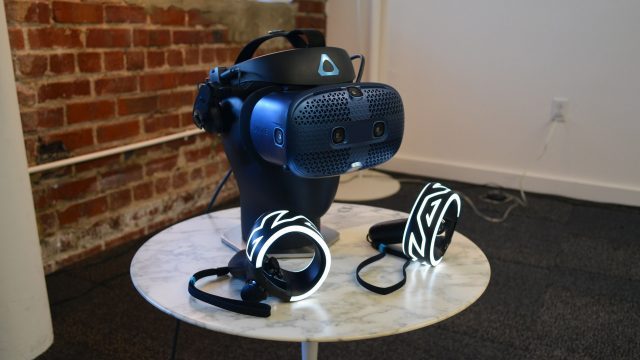
Perhaps the single biggest change to Cosmos is its use of inside-out tracking. The headset comes equipped with six on-board cameras which detect the position of the headset and controllers. This eliminates the need for the SteamVR Tracking base stations used with the original Vive and Vive Pro, which moves the headset closer to a plug-and-play experience without the need to set up any external tracking hardware.
However, HTC is thoughtfully not abandoning external tracking altogether like Oculus chose to do when moving to inside-out tracking with the Rift S. HTC built Cosmos with a modular faceplate, and the company plans to offer an optional faceplate which adds the sensors necessary for SteamVR Tracking. It’s great that customers will have that choice, but unfortunately the module isn’t planned for release until Q1 2020. That said, my hands-on was with the headset and its default inside-out tracking system.
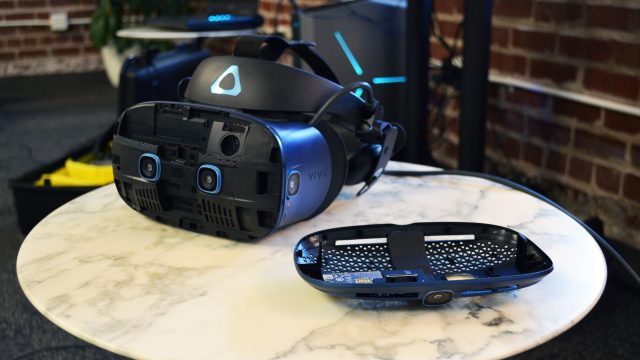
In my hour or so in the headset, the inside-out head-tracking felt very solid and quite on par with Oculus Quest and Rift S (both of which also use inside-out tracking). I’ll need to test the system in more challenging conditions to understand its robustness, but the initial impressions are good.
Hand-tracking is another story. While the controller tracking felt solid overall, it was easy to spot moments of jitter here and there (where the controller would drift an inch out of position before quickly popping back into place) even when when moving the controllers slowly. That said, my initial impressions are that the controllers are still in the ‘better than PlayStation Move’ category, which means they’ll likely be acceptable for a wide range of games, but may be problematic for more precise use-cases like drawing and modeling in VR, and games where controller occlusion is common.
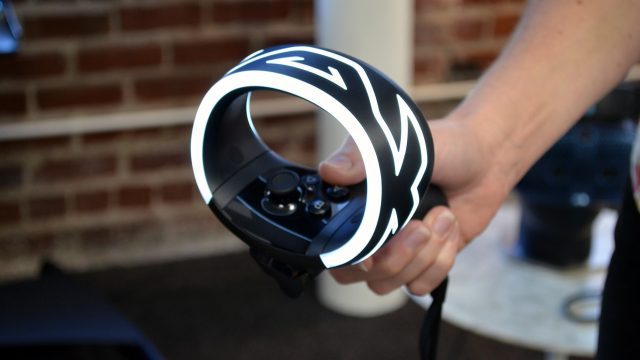
I’m going to need more time with the controllers to get a good sense for how they’ll perform in the more challenging use-cases and environments, though it’s worth remembering that if the tracking doesn’t cut it for a particular user, they’ll be able to opt for controllers which use the bar-setting SteamVR Tracking system instead.
The controllers themselves bear a strong resemblance to Oculus’ Touch controllers, and move away from the capacitive touchpad on the Vive wand controllers to a thumbstick, and mostly brings them in line with Touch and Index controllers in terms of buttons and sticks (which is going to be a boon for developers who will no longer need to juggle significantly different input schemes when designing their games). HTC didn’t want to make life too easy for developers though, and opted to introduce a ‘shoulder’ button above the trigger which is not shared by any contemporary VR controller. While the ‘grab’ trigger is actually a button, it’s significantly easier to keep depressed than the grab buttons on the original Vive controllers, and should be comfortable enough for the ‘continuous hold’ grabbing paradigm shared by Touch and Index controllers.
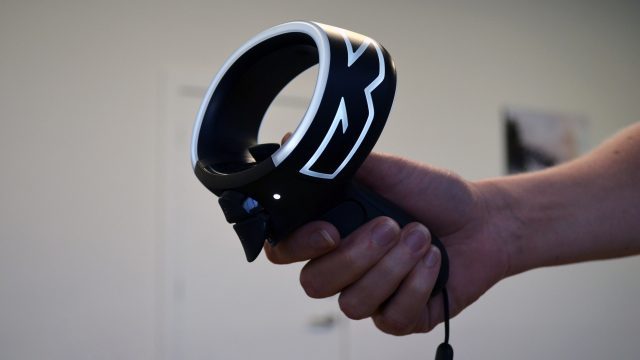
When it comes to controller ergonomics, Cosmos’ controllers feel particularly heavy (likely owed in part to the use of two AA batteries) and they have a poor center of gravity. While certainly usable, and a step up from the larger wands, they don’t feel quite as good in the hand as the similarly shaped Touch controllers.
On the visual front, Vive Cosmos gets a solid screen upgrade which brings it to 1,440 × 1,700 up from the original Vive’s 1,080 × 1,280 display. Like its contemporaries, Cosmos is also moving from OLED to LCD, which has the benefits of full RGB sub-pixels for each pixel, which reduces the screen door effect (SDE) compared to a OLED, but also means worse contrast ratio, which is most notable in dark scenes. The screen door is not invisible, but it’s a pretty prominent reduction compared to the original Vive. As far as SDE goes, Cosmos is definitely in the same class as Index, Rift S, and Vive Pro, and might just barely have the edge over that bunch (but I can’t say for sure before until I have can make proper side-by-side comparisons).
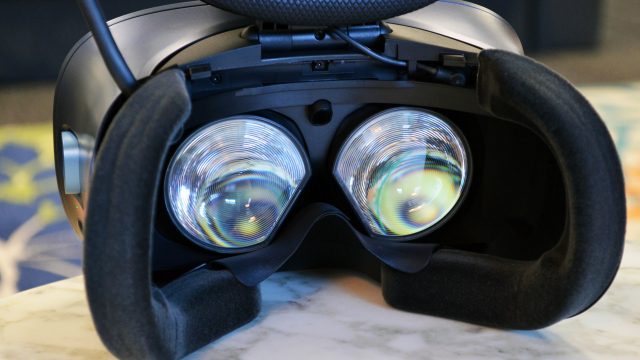
While HTC says Cosmos’ lenses are new and improved, they take the same Fresnel approach as seen on the original Vive and Vive Pro, which means they show glare and god-rays in the expected high contrast situations. Quoted at 110 degrees diagonal, HTC says Cosmos has the same field of view as the original Vive, but to my eyes it actually seemed a bit larger (which may simply be due to how the headset fits against my face compared to the original).
From my time with the headset, unfortunately it doesn’t seem that the new lenses have done much to improve the notoriously small ‘sweet-spot’ (the area of the lens with maximum clarity) of the Vive headsets. While an IPD adjustment means you’ll be able to dial-in the proper distance between your eyes, you don’t have to look very far from the center of the lens before the world becomes annoying blurry.
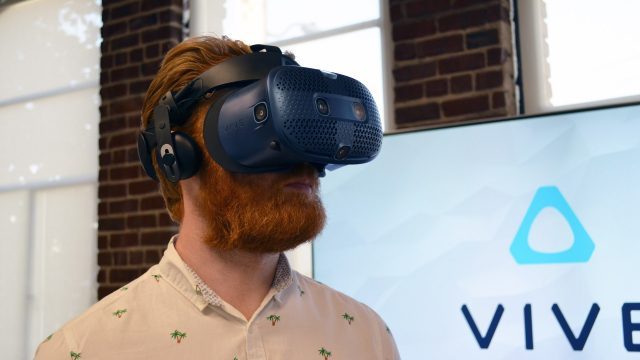
The sweet spot issue is compounded by the headset’s not particularly encouraging ergonomics. Cosmos is moving to a halo style head-mount which is quite similar to what we see on the Rift S (crank in the back for tightening and a top-strap). Also like Rift S, the Cosmos head-mount seems to give you two mutually exclusive choices: comfort or clarity. When I put on the headset for the first time, I naturally dialed things in to get the best view through the lenses. It wasn’t very long before I started to feel a lot of pressure on my forehead and wanted to reseat the headset for better comfort.
Unfortunately moving it to a more comfortable position meant the visor tilted away from my face and in doing so opened a large gap for light at the bottom of the visor and simultaneously moved my eyes out of the sweet spot (reducing clarity and field of view). The halo style head-mount, it seems, may be quite depend on a particular head shape, with the biggest issue apparently being the inability to rotate the visor with respect to the face independent of the head-mount position. On the positive side, Cosmos does have a ‘flip-up’ visor which is nice for quickly peeking outside of the headset without awkwardly balancing it on your forehead.
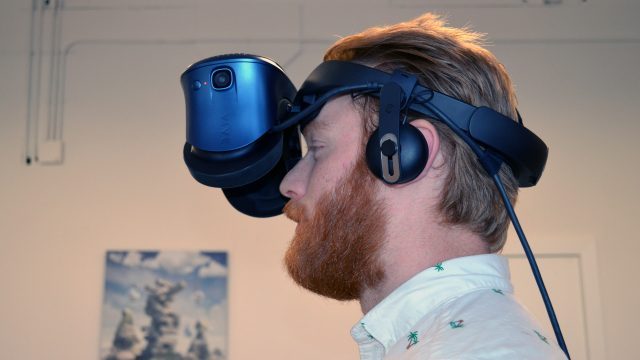
I’ll need more time with Cosmos to find out if there’s some magic position which allows for a satisfying level of simultaneous comfort and clarity, but my initial impressions haven’t left me particularly hopeful. Your mileage may vary (based on the shape of your head).
Cosmos also comes with integrated headphones by default. The headphones are very similar to what’s found on the Vive Deluxe Audio Strap accessory for the original Vive, and sound similar too, though I didn’t have the opportunity to delve into an audio quality analysis. I did learn that the headphones can be removed and an on-board 3.5mm headphone jack will allow users to use their own headphones if desired.
With changes to tracking, controller design, and a modular concept which may further expand the headset’s capabilities over time, HTC is aiming to reboot the Vive experience with Cosmos. We’ll be bringing you a full in-depth review of Cosmos in the coming weeks, but drop us a line in the comments below if you have any questions about our hands-on preview.







